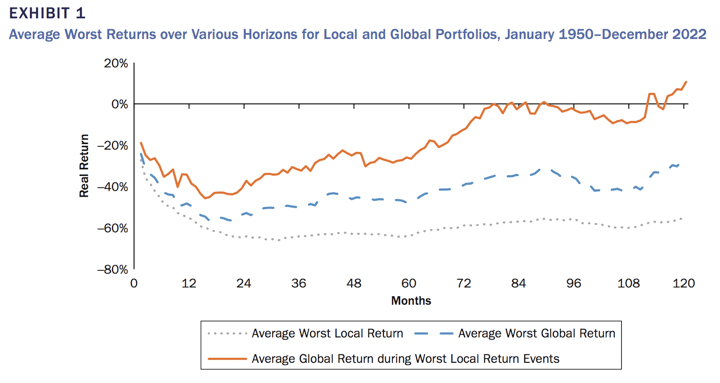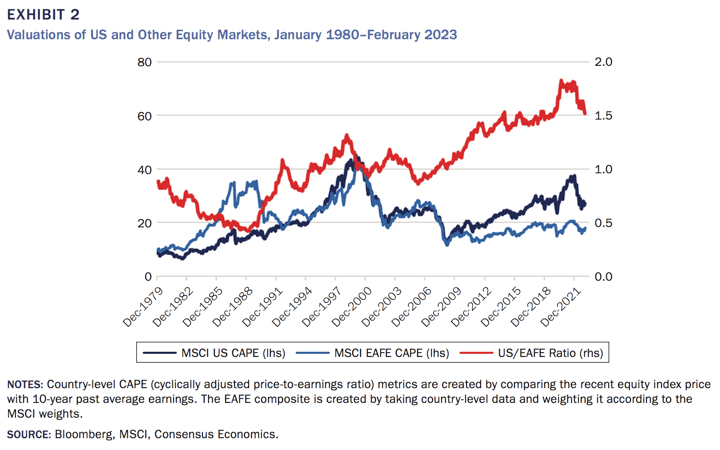If you own a target retirement fund, you probably own a decent chunk of international stocks. However, these days it’s harder to find people telling you to own international stocks when you build your own portfolio, mostly because of the outperformance of US stocks over non-US stocks for long time now. The article International Diversification – Still Not Crazy after All These Years does a good job of reminding us why owning some international stocks is still a good idea. Here’s the brief summary:
International diversification has hurt US-based investors for over 30 years, but the long-run case for it remains relevant. Both financial theory and common sense favor international diversification, which is buttressed by empirical evidence that is very supportive at longer horizons and for active strategies. Finally, it would be dangerous to extrapolate the post-1990 outperformance of US equities, as it mainly reflects rising relative valuations. If anything, the current richness of US equities may point to prospective underperformance.
For one, the diversification benefits in times of market crashes are still there… as long as you expand your time horizon. The major risk for a US-only portfolio is a prolonged recession in the US, while the rest of the world recovers more quickly. The “insurance” analogy still applies as historically there has definitely been a cushioning effect over time from spreading your bets.
Exhibit 1 shows that over short horizons, global portfolios (dashed) can suffer almost as much as an average local portfolio (dot- ted); but once you look out a couple years or so, global portfolios fare much better.

Exhibit 2 tracks the Shiller CAPE ratio (Cyclically-Adjusted Price/Earnings ratio) of US stocks and EAFE developed international stocks. The red line represents ratio between the US and EAFE valuations. Much of the historical outperformance of the US over EAFA stocks since 1990 was not earnings growth itself, but expansion of the P/E ratio (how much you pay for those earnings).

Will US stocks permanently maintain a P/E ratio that is 50% higher than international stocks? I have no idea, but it’s definitely not a sure thing. I let my portfolio asset allocation float with the market weightings (with a slight US tilt since I live here), so I don’t really worry about it because if US stocks keep growing faster than international stocks, then I’ll just gradually end up owning more US stocks while paying a sort of insurance premium hit for owning the international stocks. But if international stocks end up making even a minor improvement like a return to valuation ratios pre-2010, my portfolio can still benefit.
 The Best Credit Card Bonus Offers – 2025
The Best Credit Card Bonus Offers – 2025 Big List of Free Stocks from Brokerage Apps
Big List of Free Stocks from Brokerage Apps Best Interest Rates on Cash - 2025
Best Interest Rates on Cash - 2025 Free Credit Scores x 3 + Free Credit Monitoring
Free Credit Scores x 3 + Free Credit Monitoring Best No Fee 0% APR Balance Transfer Offers
Best No Fee 0% APR Balance Transfer Offers Little-Known Cellular Data Plans That Can Save Big Money
Little-Known Cellular Data Plans That Can Save Big Money How To Haggle Your Cable or Direct TV Bill
How To Haggle Your Cable or Direct TV Bill Big List of Free Consumer Data Reports (Credit, Rent, Work)
Big List of Free Consumer Data Reports (Credit, Rent, Work)
Since so many “US” stocks also have a foreign exposure it would be interesting to see how much foreign investment a strictly “US” fund has.
“International diversification has hurt US-based investors for over 30 years….” That has been the greater part of my investing time period. I used to own some international funds, believing all I read about that being important for a well diversified portfolio. Except for an occasional good year now and then, I found that holding international funds just generally dragged down my total performance. I still have international exposure, primarily through some life stage and target date funds from workplace 401-K plans – so I’m hoping to eventually see some benefit from international investing.
Mark C. Bach — I get what you’re saying. Any mutual fund holding multinational companies — Home Depot, Coca Cola, Nike, etc. — is performing to a large extent based on foreign earnings.